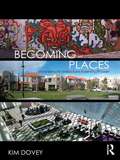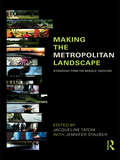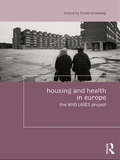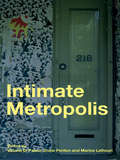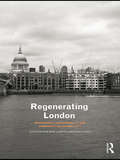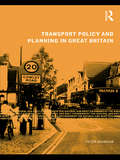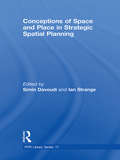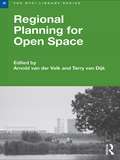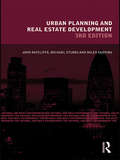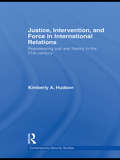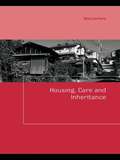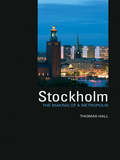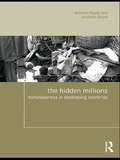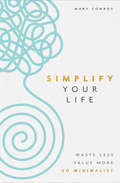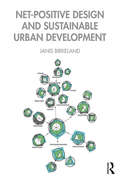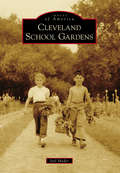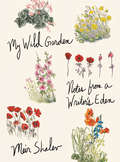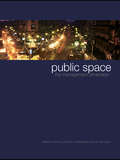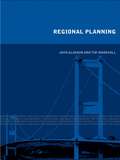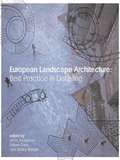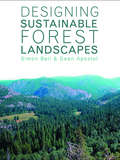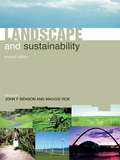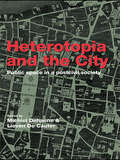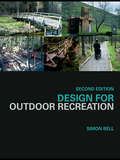- Table View
- List View
Becoming Places: Urbanism / Architecture / Identity / Power
by Kim DoveyAbout the practices and politics of place and identity formation – the slippery ways in which who we are becomes wrapped up with where we are – this book exposes the relations of place to power. It links everyday aspects of place experience to the social theories of Deleuze and Bourdieu in a very readable manner. This is a book that takes the social critique of built form another step through detailed fieldwork and analysis in particular case studies. Through a broad range of case studies from nationalist monuments and new urbanist suburbs to urban laneways and avant garde interiors, questions are explored such as: What is neighborhood character? How do squatter settlements work and does it matter what they look like? Can architecture liberate? How do monuments and public spaces shape or stabilize national identity?
Making the Metropolitan Landscape: Standing Firm on Middle Ground
by Jacqueline Tatom Jennifer StauberThe American landscape is an extremely complex terrain born from a history of collective and individual experiences. These created environments, which all may be called metropolitan landscapes, constantly challenge students and professionals in the fields of architecture, design and planning to consider new ways of making lively public places. This book brings together varied voices in urban design theory and practice to explore new ways of understanding place and our position in it.
Housing and Health in Europe: The WHO LARES project (Housing and Society Series)
by David OrmandyIn this cross-disciplinary research David Ormandy and expert contributors explain the nature and development of the World Health Organization's study of housing across Europe. In-depth analysis provides new evidence of links between the health of inhabitants and their housing conditions, with focus on critical topics such as: indoor air pollution the effect of cold homes and dampness noise effects domestic accidents. With practical examples of survey tools, the attention given to methodological approaches makes this text an important resource for policy professionals as well as housing, planning and public health academics.
Intimate Metropolis: Urban Subjects in the Modern City
by Vittoria Di Palma Diana Periton Marina LathouriIntimate Metropolis explores connections between the modern city, its architecture, and its citizens, by questioning traditional conceptualizations of public and private. Rather than focusing purely on public spaces—such as streets, cafés, gardens, or department stores—or on the domestic sphere, the book investigates those spaces and practices that engage both the urban and the domestic, the public and the private. The legal, political and administrative frameworks of urban life are seen as constituting private individuals’ sense of self, in a wide range of European and world cities from Amsterdam and Barcelona to London and Chicago. Providing authoritative new perspectives on individual citizenship as it relates to both public and private space, in-depth case studies of major European, American and other world cities and written by an international set of contributors, this volume is key reading for all students of architecture.
Regenerating London: Governance, Sustainability and Community in a Global City
by Rob Imrie Loretta Lees Mike RacoRegenerating London explores latest thinking on urban regeneration in one of the fastest changing world cities. Engaging with social, economic, and political structures of cities, it highlights paradoxes and contradictions in urban policy and offers an evaluation of the contemporary forms of urban redevelopment.
I Modify IKEA: Furnishings from Everyone's Favorite Store, Customized for Your Home
by Elyse Major Charlotte RiversCUSTOMIZE YOUR FAVORITE IKEA® HOME FURNISHINGS WITH DIY PROJECTS You love IKEA® for its affordable, high-quality home furnishings. Now thanks to this book&’s DIY decorating projects, you can easily transform those furnishings into fully customized decor. Packed with 200 step-by-step illustrations and instructions, I Modify IKEA® offers a range of inspiring ideas to reflect your unique style. Living room: appliqué pillows Dining room: a rolling bar cart Kitchen: embroidered dish towels Bedroom: decorated nightstands Closet: an adorable jewelry box Bathroom: unique shelving Kid's room: a box set dollhouse Office: a cozy reading bench.
Transport Policy and Planning in Great Britain (Natural and Built Environment Series #Vol. 5)
by Peter HeadicarTransport in the twenty-first century represents a significant challenge at the global and the local scale. Aided by over sixty clear illustrations, Peter Headicar disentangles this complex, modern issue in five parts, offering critical insights into: the nature of transport the evolution of policy and planning policy instruments planning procedures the contemporary agenda. Distinctive features include the links forged throughout between transport and spatial planning, which are often neglected. Designed as an essential text for transport planning students and as a source of reference for planning practitioners, it also furthers understanding of related fields such as urban and regional planning, geography, environmental studies and public policy. Based in the postgraduate course the author developed at Oxford Brookes University, this indispensable text draws on a lifetime of professional experience in the field.
Conceptions of Space and Place in Strategic Spatial Planning (RTPI Library Series)
by Simin Davoudi Ian StrangeBringing together authors from academia and practice, this book examines spatial planning at different places throughout the British Isles. Six illustrative case studies of practice examine which conceptions of space and place have been articulated, presented and visualized through the production of spatial strategies. Ranging from a large conurbation (London) to regional (Yorkshire and Humber) and national levels, the case studies give a rounded and grounded view of the physical results and the theory behind them. While there is widespread support for re-orienting planning towards space and place, there has been little common understanding about what constitutes ‘spatial planning’, and what conceptions of space and place underpin it. This book addresses these questions and stimulates debate and critical thinking about space and place among academic and professional planners.
Regional Planning for Open Space (RTPI Library Series)
by Arnold Van Der Valk Terry Van DijkReviewing the limitations of various planning options, this book addresses the debate on how to preserve open space in the context of a growing metropolis. The importance of open spaces for well-being in urban life is well-established. With case studies on internalization and valuation methods, this book critically examines the liberal discourse that urges the transfer of responsibility for open space from government to the market. European and American expert authors confront political rhetoric with grounded analysis and conclude that the market needs to be combined with governmental efforts. They scrutinize the connection between open space and the planning institutions designed to implement its policy. The book provides practical pieces of insight in how to structure an open space problem, information on what to expect from instruments, and new ideas on alternative approaches.
Urban Planning and Real Estate Development (Natural and Built Environment Series)
by John Ratcliffe Michael Stubbs Miles KeepingThe twin processes of planning and property development are inextricably linked – it’s not possible to carry out a development strategy without an understanding of the planning process, and equally planners need to know how real estate developers do their job. This third edition of Urban Planning and Real Estate Development guides students through the procedural and practical aspects of developing land from the point of view of both planner and developer. The planning system is explained, from the increasing emphasis on spatial planning at a regional level down to the detailed perspective of the development control process and the specialist requirements of historic buildings and conservation areas. At the same time the authors explain the entire development process from inception through appraisal, valuation and financing to completion and disposal. This is an invaluable textbook for real estate and planning students, and helps to meet the requirements of the RICS and RTPI Assessment of Professional Competence.
Justice, Intervention, and Force in International Relations: Reassessing Just War Theory in the 21st Century (Contemporary Security Studies)
by Kimberly A. HudsonThis book analyses the problems of current just war theory, and offers a more stable justificatory framework for non-intervention in international relations. The primary purpose of just war theory is to provide a language and a framework by which decision makers and citizens can organize and articulate arguments about the justice of particular wars. Given that the majority of conflicts that threaten human security are now intra-state conflicts, just war theory is often called on to make judgments about wars of intervention. This book aims to critically examine the tenets of just war theory in light of these changes, and formulate a new theory of intervention and just cause. For Michael Walzer, the leading scholar of just war theory, armed humanitarian intervention is permissible only in cases of genocide, ethnic cleansing, widespread massacres, or enslavement. This book shows why this threshold is too restrictive in light of the progressive shift away from interstate conflict as well as the emerging norms of 'sovereignty as responsibility' and the 'responsibility to protect'. Justice, Intervention and Force in International Relations aims to establish a new, stable foundation for non-intervention and a revised threshold for 'just cause'. In addition, this book demonstrates that over-reliance on the just cause category distorts understanding, analysis, and public discussion of the justice or injustice of resorting to war. This new book will be of much interest to students of ethics, security studies, international relations and international law. Kimberley Hudson is Assistant Professor of Political Science at American International College, and has a Phd in International Relations from Brown University.
Housing, Care and Inheritance (Housing and Society Series)
by Misa IzuharaHousing, Care and Inheritance draws on the author’s long-standing research into housing issues surrounding the ageing society, a phenomenon which is now a concern in many mature economies. If an adult child provides care for their elderly parent, should that person be rewarded? If so, should they inherit their parent’s house or a larger share of the assets? The ‘generational contract’ is often influenced by cultural norms, family traditions, social policy and housing market, so it is negotiated differently in different societies and at different times. Such generational contract is however breaking down as a result of socio-economic and demographic changes. Drawn from the two-part study funded by the UK Economic & Social Research Council, Misa Izuhara explores the myth and the changing patterns of the particular exchange of long-term care and housing assets between older parents and their adult children in Britain and Japan. Highly international and comparative in perspectives, this study addresses important sociological as well as policy questions regarding intergenerational relations involving housing wealth, long-term care, and inheritance.
Stockholm: The Making of a Metropolis (Planning, History and Environment Series)
by Thomas HallThis is the first history of Stockholm’s development from the city’s unique seventeenth-century redevelopment and extension to the postmodern, postindustrial trends of today. While the city’s planners borrowed the ideas from abroad at certain periods, they provided the lead for the rest of the world at others. For much of the mid-twentieth century Stockholm was the model for Europe and elsewhere. Written by an acknowledged authority on the city and Swedish architecture and planning generally, with a wide range of illustrations, this book provides a much needed explanation of one of Europe’s great cities.
The Hidden Millions: Homelessness in Developing Countries (Housing and Society Series)
by Graham Tipple Suzanne SpeakThis book explores the extent, causes and characteristics of homelessness in developing countries. Bringing together a major review of literature and empirical case studies, it is invaluable for those studying, researching or working in housing, homelessness, social policy or urban poverty. Drawing on local research in nine countries in the global south, this book offers an insight into the lives of homeless people, public perceptions of homelessness, and the policies and interventions which might variously increase or reduce homelessness. Exploring the human context as well as policy and planning, it will challenge preconceptions.
Simplify Your Life: Waste Less, Value More, Go Minimalist
by Mary ConroyMinimalism is for rich people who live in big, empty, white homes, right? Wrong. Minimalism can be a beautiful, enriching and life-transforming practice that, at its core, is all about re-establishing what holds value in your life and letting go of what does not. It's not about having your groceries displayed in glass jars or having chic, Scandinavian furniture - it's a way of life that allows us to strip away the clutter that stands in the way of us achieving our goals. Simplify Your Life is about exactly that: bringing simplicity back into your life, and with it, joy in the everyday. Dispelling the myths that minimalism is for either hardcore environmentalists or the privileged few, this book shows how minimalism is more relevant and necessary than ever, not least because it's the most accessible way to achieve a state of contentment in all aspects of life. Minimalism is for you if you want to: • stop mindlessly scrolling and start living with intention and purpose • spend more time on the things and people you love and less on what you "have to be/do" • take control of your finances and stop mindless spending • learn more about conscious consumption and reducing your waste • experience freedom and pride in your home instead of feeling trapped by your stuffAlthough minimalism is ostensibly about taking things away from our cluttered lives, it is really about adding richness, color, and meaning to our lives. It's about identifying the aspects of our life that we truly love and that nourish us. It's about trusting ourselves and leading the life we always wanted.
Net-Positive Design and Sustainable Urban Development
by Janis Birkeland‘Sustainable’ urban planning, policy and design professes to solve sustainability problems, but often depletes and degrades ever more resources and ecosystems and concentrates wealth and concretize social disparities. Positive Development theory holds that development could create more net ecological and social gains than no construction at all. It explains how existing conceptual, physical and institutional structures are inherently biased against the preservation and expansion of social and natural life-support systems, and proposes explicit reforms to planning, design and decision making that would enable development to increase future options and social and natural life-support systems – in absolute terms. Net-Positive Design and Sustainable Urban Development is aimed at students, academics, professionals and sustainability advocates who wonder why existing approaches have been ineffective. It explains how to reform the anti-ecological biases in our current frameworks of environmental governance, planning, decision making and design – and suggests how to make these changes. Cities can increase both the ‘public estate’ (reduce social stratification, inequity and other causes of conflict, increase environmental quality, wellbeing and access to basic needs, etc.); and the ‘ecological base’ (sequester more carbon and produce more energy than used during construction and operation, increase ecological space to support ecological carrying capacity, ecosystem functions and services, restore the bioregions and wilderness, etc.). No small task, this new book provides academic theory and professional tools for saving the planet, including a free computer app for net-positive design.
Cleveland School Gardens (Images of America)
by Joel MaderThe Cleveland Public School's tract garden program was one of the most successful and innovative programs of the school system. The organization and beauty of the gardens attracted horticulture educators from all over the United States, South America, and as far away as Japan. From its humble beginnings in 1904 as a project to beautify vacant lots in Cleveland, it grew into an educational tool that taught thousands of children the respect for nature and its bounty. At the tract gardens' height, the amount of land under cultivation in the middle of the Cleveland urban landscape approached 100 acres. By 1970, there were 27 horticultural centers servicing all Cleveland schools. Centers were located next to schools, in housing estates, at fairgrounds, at a home for the aged, and on museum property. A few of the centers are now neighborhood gardens. The photographs in Cleveland School Gardens show that the Cleveland Public Schools knew the importance of being "green" 100 years before it was politically fashionable.
My Wild Garden: Notes from a Writer's Eden
by Meir ShalevA colorfully illustrated round of the season in the garden of the best-selling novelist, memoirist, and champion putterer with a wheelbarrow On the perimeter of Israel&’s Jezreel Valley, with the Carmel mountains rising up in the west, Meir Shalev has a beloved garden, &“neither neatly organized nor well kept,&” as he cheerfully explains. Often covered in mud and scrapes, Shalev cultivates both nomadic plants and &“house dwellers,&” using his own quirky techniques. He extolls the virtues of the lemon tree, rescues a precious variety of purple snapdragon from the Jerusalem–Tel Aviv highway, and does battle with a saboteur mole rat. He even gives us his superior private recipe for curing olives. Informed by Shalev&’s literary sensibility, his sometime riotous humor, and his deep curiosity about the land, My Wild Garden abounds with appreciation for the joy of living, quite literally, on Earth. Our borrowed time on any particular patch of it is enhanced, the author reminds us, by our honest, respectful dealings with all manner of beings who inhabit it with us.
Public Space: The Management Dimension
by Matthew Carmona Claudio De Magalhães Leo HammondIn both the UK and the US there is a sense of dissatisfaction and pessimism about the state of urban environments, particularly with the quality of everyday public spaces. Explanations for this have emphasized the poor quality of design that characterizes many new public spaces; spaces that are dominated by parking, roads infrastructure, introspective buildings, a lack of enclosure and a poor sense of place, and which in different ways for different groups are too often exclusionary. Yet many well designed public spaces have also experienced decline and neglect, as the services and activities upon which the continuing quality of those spaces have been subject to the same constraints and pressures for change as public services in general. These issues touch upon the daily management of public space, that is, the coordination of the many different activities that constantly define and redefine the characteristics and quality of public space. This book draws on three empirical projects to examine the questions of public space management on an international stage. They are set within a context of theoretical debates about public space, its history, contemporary patterns of use and changing nature in western society, and about the new management approaches that are increasingly being adopted.
Regional Planning: Concepts, Theory And Practice (Natural and Built Environment Series)
by John Glasson Tim MarshallRegional Planning provides a comprehensive introduction to the concepts and theory of regional planning in the UK. Drawing on examples from throughout the UK, it provides students and practitioners with a descriptive and analytical foundation for understanding this rapidly changing area of planning. The book includes four main sections covering: the context and history of regional planning theoretical approaches evolving practice future prospects. New questions and methods of theorizing are explored and new connections made with contemporary debates in geography, political science and planning theory. The elements of critical analysis allow both practitioners and more advanced students to reflect upon their activities in a contemporary context. Regional Planning is the essential, up-to-date text for students interested in all aspects of this increasingly influential subject.
European Landscape Architecture: Best Practice in Detailing
by Ian H. Thompson Torben Dam Jens Balsby NielsonDrawing together case studies from all over Europe, this text explores the relationship between the overall idea of the landscape architecture for a site and the design of details. Examining concept sketches and design development drawings in relation to the details of the design, the book offers a more profound understanding of decision making through all stages of the design process. The book includes the study of the choice of materials and techniques of construction, and explores the cultural and symbolic significance of such choices, as well as questions of environmental sustainability. With projects analyzed and evaluated here that have won international acclaim, or have been awarded national prizes, European Landscape Architecture is a core book in the study and understanding of the subject.
Designing Sustainable Forest Landscapes
by Simon Bell Dean ApostolDesigning Sustainable Forest Landscapes is a definitive guide to the design and management of forest landscapes, covering the theory and principles of forest design as well as providing practical guidance on methods and tools. Including a variety of international case studies the book focuses on ecosystem regeneration, the management of natural forests and the management of plantation forests. Using visualisation techniques, design processes and evaluation techniques it looks at promoting landscapes which are designed to optimise the balance between human intervention and natural evolution. A comprehensive, practical and accessible book, Designing Sustainable Forest Landscapes is essential reading for all those involved in forestry and landscape professions.
Landscape and Sustainability
by John F Benson Maggie RoeThis unique book addresses the issue of sustainability from the point of view of landscape architecture, dealing with professional practices of planners, designers and landscape managers. This second edition contains updated and new material reflecting developments during the last five years and comprehensively addresses the relationship between landscape architecture and sustainability. Much in the text is underpinned by landscape ecology, in contrast to the idea of landscape as only appealing to the eye or aspiring cerebrally to be fine art. Landscape and Sustainability establishes that the sustainability agenda needs a new mindset among professionals: the driving question must always be ‘is it sustainable?’ Developing theory into practice, from the global to the local scale and from issues of policy and planning through to detailed design and implementation and on to long-term maintenance and management, the contributors raise and re-examine a complex array of research, policy and professional issues and agendas to contribute to the necessary ongoing debate about the future of both landscape and sustainability.
Heterotopia and the City: Public Space in a Postcivil Society
by Michiel Dehaene Lieven De CauterHeterotopia, literally meaning ‘other place’, is a rich concept in urban design that describes a space that is on the margins of ordered or civil society, and one that possesses multiple, fragmented or even incompatible meanings. The term has had an impact on architectural and urban theory since it was coined by Foucault in the late 1960s but it has remained a source of confusion and debate since. Heterotopia and the City seeks to clarify this concept and investigates the heterotopias which exist throughout our contemporary world: in museums, theme parks, malls, holiday resorts, gated communities, wellness hotels and festival markets. With theoretical contributions on the concept of heterotopia, including a new translation of Foucault’s influential 1967 text, Of Other Space and essays by well-known scholars, the book comprises a series of critical case studies, from Beaubourg to Bilbao, which probe a range of (post)urban transformations and which redirect the debate on the privatization of public space. Wastelands and terrains vagues are studied in detail in a section on urban activism and transgression and the reader gets a glimpse of the extremes of our dualized, postcivil condition through case studies on Jakarta, Dubai, and Kinshasa. Heterotopia and the City provides a collective effort to reposition heterotopia as a crucial concept for contemporary urban theory. The book will be of interest to all those wishing to understand the city in the emerging postcivil society and post-historical era. Planners, architects, cultural theorists, urbanists and academics will find this a valuable contribution to current critical argument.
Design for Outdoor Recreation
by Simon BellDesign for Outdoor Recreation takes a detailed look at all aspects of design of facilities needed by visitors to outdoor recreation destinations. The book is a comprehensive manual for planners, designers and managers of recreation taking them through the processes of design and enabling them to find the most appropriate balance between visitor needs and the capacity of the landscape. A range of different aspects are covered including car parking, information signing, hiking, waterside activities, wildlife watching and camping. This second edition incorporates new examples from overseas, including Australia, New Zealand, Japan and Eastern Europe as well as focusing on more current issues such as accessibility and the changing demands for recreational use.
